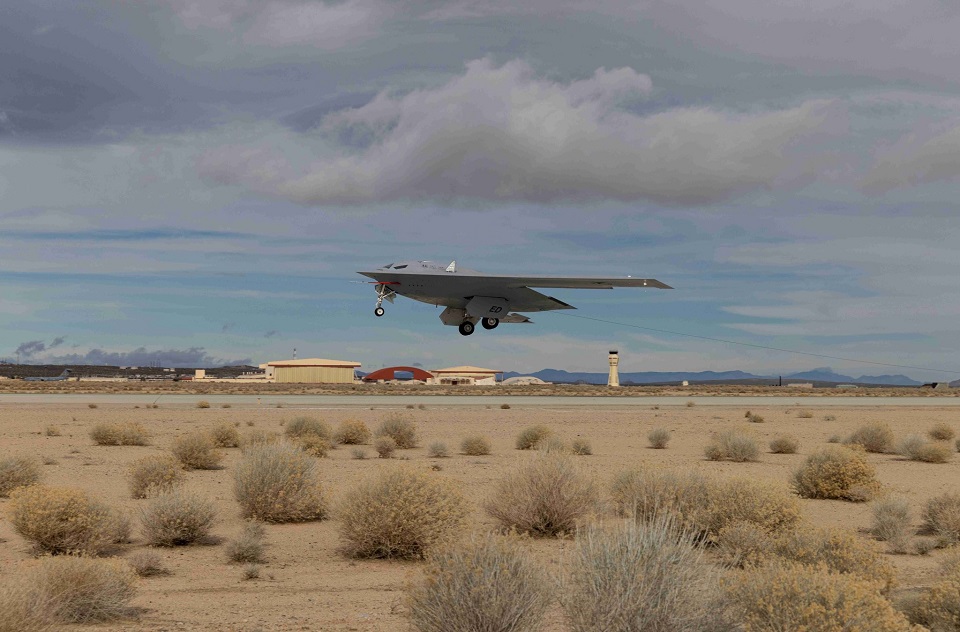Aerospace
Take First Glimpse of USAF B-21 Raider, Latest Nuclear Stealth Bomber

The United States Air Force (USAF) has unveiled the first photographs of the Northrop Grumman B-21 Raider bomber in flight.
These images were captured during test flights conducted by the B-21 Combined Test Force at Edwards Air Force Base, marking a significant milestone in the development of this sixth-generation aircraft.
Currently undergoing flight tests in California, the B-21 Raider represents the next generation of stealth bombers. With an estimated cost of around $700 million per aircraft, the B-21 Raider is poised to become a crucial component of the USAF’s arsenal for conventional Long Range Strike missions.
According to Air Force briefings, the B-21 Raider will form part of a comprehensive family of systems, encompassing Intelligence, Surveillance, and Reconnaissance capabilities, electronic warfare, communication systems, and more. Notably, the bomber will be nuclear-capable and adaptable for both manned and unmanned operations.
It boasts the flexibility to deploy a wide array of stand-off and direct-attack munitions, ensuring versatility in various combat scenarios. One of the B-21’s distinguishing features is its extensive integration of digital technology, as highlighted in discussions held during a Senate Armed Services Committee hearing.
Designed with an open systems architecture, the B-21 Raider is built to swiftly incorporate emerging technologies, ensuring its effectiveness against evolving threats over time. The B-21 Raider is slated to replace the aging B-1 Lancer and B-2 Spirit bombers, bolstering US national security objectives and providing reassurance to allies and partners worldwide.

Aerospace
Boeing Transfers Rocket Stage to NASA, Paving Way for Human Moon Mission

Boeing has achieved a significant milestone by providing NASA with the second core stage of the Space Launch System (SLS) rocket.
This crucial component, crafted at NASA’s Michoud Assembly Facility (MAF), is set to propel the Artemis II crew into lunar orbit, marking humanity’s return to deep space after a 50-year hiatus.
The monumental Boeing-built rocket stage, the largest element of the Artemis II mission, will embark on a journey aboard the Pegasus barge, traveling 900 miles to NASA’s Kennedy Space Center.
Comparison of two legendary aircraft B777x vs B747 aircraft:Click here
Upon arrival, it will be meticulously integrated with other essential Artemis II components, including the upper stage, solid rocket boosters, and NASA’s Orion spacecraft within the iconic Vehicle Assembly Building. This intricate integration process is a vital step toward the eagerly anticipated Artemis II launch, slated for 2025.
“Boeing-built products helped land humankind on the moon in 1969, and we’re proud to continue that legacy through the Artemis generation,” remarked Dave Dutcher, vice president and program manager for Boeing’s SLS program. “Together, with NASA and our industry partners and suppliers, we are building the world’s most capable rocket and paving the way to deep space through America’s rocket factory in New Orleans.”
NASA, Lockheed Martin Reveal X-59 Quiet Supersonic Aircraft:Click here
The delivery of Core Stage 2 marks a significant achievement in the evolution of the SLS rocket. Towering over 200 feet and powered by four RS-25 engines, this core stage, coupled with two solid-fueled booster rockets, will generate a staggering 8.8 million pounds of thrust. This immense power is crucial to launching Artemis II and future missions into the vast expanse of space.
The SLS rocket stands unparalleled in its capability to transport both crew and substantial cargo to the moon and beyond in a single launch. Its extraordinary capacity will facilitate the delivery of human-rated spacecraft, habitats, and scientific missions to destinations including the moon and Mars, ushering in a new era of space exploration.
-

 Travel1 week ago
Travel1 week agoAir India to Expand US Operations with Three New Routes After a Decade
-

 Travel2 weeks ago
Travel2 weeks agoWhy We Should Avoid These Stamps in a Passport
-

 Airlines1 month ago
Airlines1 month agoInvestigations Reveal Fake Chinese Titanium in Boeing and Airbus Jets
-

 Tech4 weeks ago
Tech4 weeks agoChina’s CATL Plans 1,800-Mile Electric Plane Launch by 2027
-

 Airport3 days ago
Airport3 days agoTop 10 Largest Airports in the World by Size
-

 Aerospace4 weeks ago
Aerospace4 weeks agoChina’s Fighter Jets Turn Wings into Autonomous Drones
-

 Airlines4 days ago
Airlines4 days agoAir India Rolls Out A350s for Delhi-New York JFK and Newark Routes
-

 Defence3 weeks ago
Defence3 weeks agoBoeing Enhances Chinook with New Engines and Block II Upgrades at $96 Million







